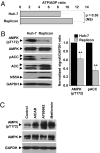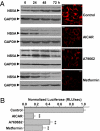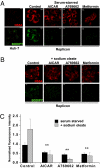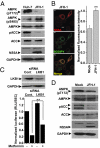Enhanced hepatitis C virus genome replication and lipid accumulation mediated by inhibition of AMP-activated protein kinase
- PMID: 20534540
- PMCID: PMC2895084
- DOI: 10.1073/pnas.0912426107
Enhanced hepatitis C virus genome replication and lipid accumulation mediated by inhibition of AMP-activated protein kinase
Abstract
Hepatitis C virus (HCV) infection is associated with dysregulation of both lipid and glucose metabolism. As well as contributing to viral replication, these perturbations influence the pathogenesis associated with the virus, including steatosis, insulin resistance, and type 2 diabetes. AMP-activated protein kinase (AMPK) plays a key role in regulation of both lipid and glucose metabolism. We show here that, in cells either infected with HCV or harboring an HCV subgenomic replicon, phosphorylation of AMPK at threonine 172 and concomitant AMPK activity are dramatically reduced. We demonstrate that this effect is mediated by activation of the serine/threonine kinase, protein kinase B, which inhibits AMPK by phosphorylating serine 485. The physiological significance of this inhibition is demonstrated by the observation that pharmacological restoration of AMPK activity not only abrogates the lipid accumulation observed in virus-infected and subgenomic replicon-harboring cells but also efficiently inhibits viral replication. These data demonstrate that inhibition of AMPK is required for HCV replication and that the restoration of AMPK activity may present a target for much needed anti-HCV therapies.
Conflict of interest statement
The authors declare no conflict of interest.
Figures





Similar articles
-
2-octynoic acid inhibits hepatitis C virus infection through activation of AMP-activated protein kinase.PLoS One. 2013 May 31;8(5):e64932. doi: 10.1371/journal.pone.0064932. Print 2013. PLoS One. 2013. PMID: 23741428 Free PMC article.
-
Endocannabinoid system activation contributes to glucose metabolism disorders of hepatocytes and promotes hepatitis C virus replication.Int J Infect Dis. 2014 Jun;23:75-81. doi: 10.1016/j.ijid.2013.12.017. Epub 2014 Apr 2. Int J Infect Dis. 2014. PMID: 24704332
-
Endocannabinoid CB1 antagonists inhibit hepatitis C virus production, providing a novel class of antiviral host-targeting agents.J Gen Virol. 2014 Nov;95(Pt 11):2468-2479. doi: 10.1099/vir.0.067231-0. Epub 2014 Jul 22. J Gen Virol. 2014. PMID: 25053565
-
Metabolic alterations and hepatitis C: From bench to bedside.World J Gastroenterol. 2016 Jan 28;22(4):1461-76. doi: 10.3748/wjg.v22.i4.1461. World J Gastroenterol. 2016. PMID: 26819514 Free PMC article. Review.
-
[Current approaches for developing new anti-HCV agents and analyses of HCV replication using anti-HCV agents].Uirusu. 2005 Jun;55(1):105-10. doi: 10.2222/jsv.55.105. Uirusu. 2005. PMID: 16308536 Review. Japanese.
Cited by
-
How Viral and Intracellular Bacterial Pathogens Reprogram the Metabolism of Host Cells to Allow Their Intracellular Replication.Front Cell Infect Microbiol. 2019 Mar 4;9:42. doi: 10.3389/fcimb.2019.00042. eCollection 2019. Front Cell Infect Microbiol. 2019. PMID: 30886834 Free PMC article. Review.
-
Modulation of autophagy-like processes by tumor viruses.Cells. 2012 Jun 25;1(3):204-47. doi: 10.3390/cells1030204. Cells. 2012. PMID: 24710474 Free PMC article.
-
Hepatitis C Virus Alters Macrophage Cholesterol Metabolism Through Interaction with Scavenger Receptors.Viral Immunol. 2022 Apr;35(3):223-235. doi: 10.1089/vim.2021.0101. Viral Immunol. 2022. PMID: 35467430 Free PMC article.
-
Insulin-induced hypoglycemia increases hepatic sensitivity to glucagon in dogs.J Clin Invest. 2010 Dec;120(12):4425-35. doi: 10.1172/JCI40919. Epub 2010 Nov 15. J Clin Invest. 2010. PMID: 21084754 Free PMC article.
-
AMP-activated protein kinase: a key regulator of energy balance with many roles in human disease.J Intern Med. 2014 Dec;276(6):543-59. doi: 10.1111/joim.12268. Epub 2014 May 27. J Intern Med. 2014. PMID: 24824502 Free PMC article. Review.
References
-
- Shepard CW, Finelli L, Alter MJ. Global epidemiology of hepatitis C virus infection. Lancet Infect Dis. 2005;5:558–567. - PubMed
-
- Moradpour D, Penin F, Rice CM. Replication of hepatitis C virus. Nat Rev Microbiol. 2007;5:453–463. - PubMed
-
- McLauchlan J. Lipid droplets and hepatitis C virus infection. Biochim Biophys Acta. 2009;1791:552–559. - PubMed
Publication types
MeSH terms
Substances
Grants and funding
LinkOut - more resources
Full Text Sources
Other Literature Sources
Medical
Molecular Biology Databases
Research Materials

